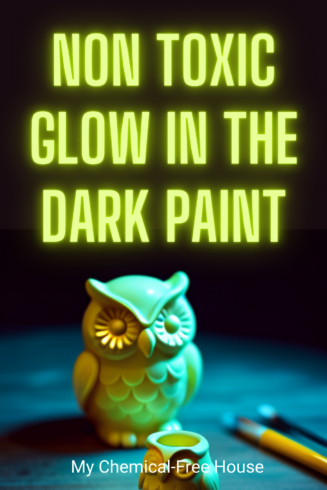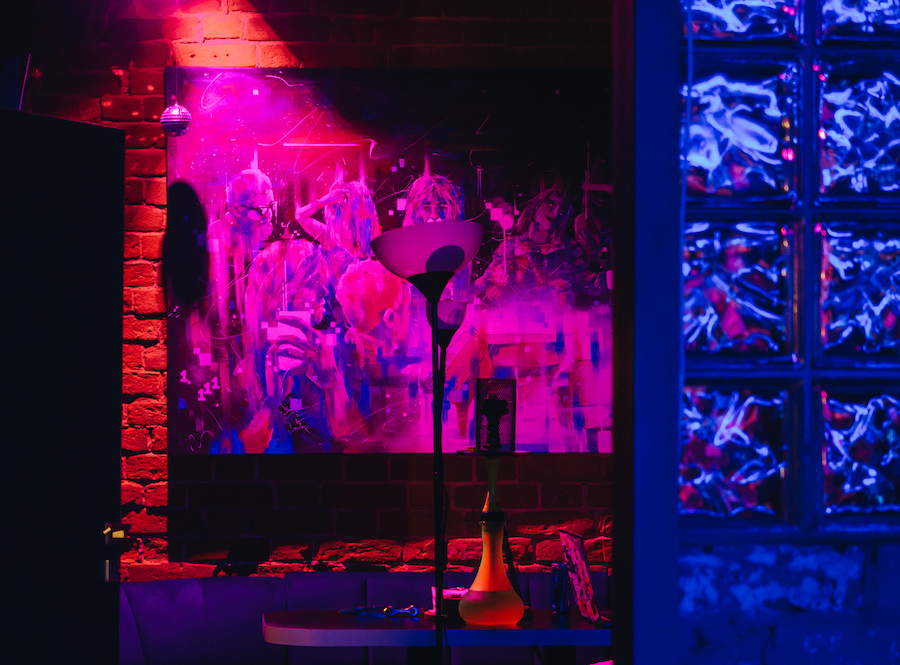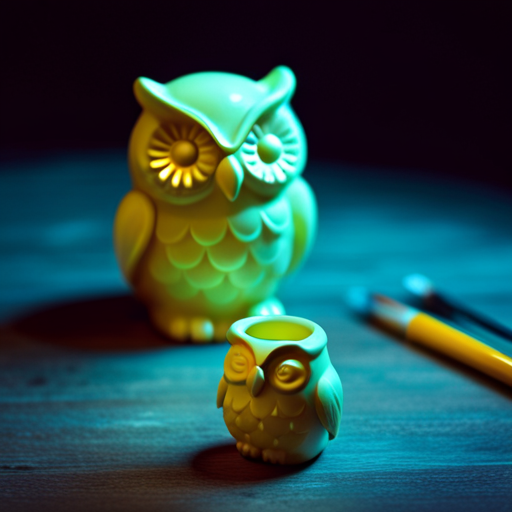Phosphorescent paint is commonly called “glow-in-the-dark” paint. It is made from phosphors such as Zinc Sulfide (doped with other metals to get different colors) or Strontium Aluminate (doped with Europium or Dysprosium) and typically glows a yellowish-green or blue color.
This article focuses on glow-in-the-dark paints used on walls, crafts, art projects, and decor items. I take a close look at what these pigment powders are and if they are really non-toxic and safe.
Expert Review: The toxicity sections were written by Dr. Lakshmi Manjunath, Board Certified Toxicologist (US and Europe).
What are glow-in-the-dark paints made of?
Zinc Sulfide-based products are the original glow-in-the-dark pigment. This is used primarily for products in the novelty category and the less expensive products for kids. This is the older type of pigment and it’s the least bright type.
The newer type of glow-in-the-dark pigment is Strontium Aluminate doped with Europium which is about ten times brighter than Zinc Sulfide. The glow also lasts ten times longer, usually for several hours, but it can go on for longer. It costs more than Zinc Sulfide.
The color of Strontium pigments can vary between various shades of green and blue. Blue tones have the longest glow time, and green produces a brighter glow.
While both types are based on earth metals, neither is considered toxic with normal use. Like most metals, you want to be careful not to inhale the powder form, and you don’t want to ingest it. Normal use of these pigments in paints used in arts, crafts, and decor is considered safe, but we are going to look at what that means exactly.
I also look at the paint base itself, and we always aim for zero VOCs in a paint. But paints made for arts and crafts do not have to declare their VOC level the way that wall paints do. While water-based acrylic arts and crafts paints are not high in VOCs, I do provide options on how you can mix the pigments with a zero-VOC paint base.
This article contains affiliate links, upon purchase I make a small commission at not extra cost to you.
Safety of Phosphorescent Pigments

Before looking at some examples of non-toxic paint brands and pigments brands let’s take a closer look at the toxicity issues with these pigments. I really wanted to understand these phosphorescent metals to make sure they were something I would actually feel safe using.
Is Zinc Sulfide Safe?
Zinc Sulfide is the main form of Zinc found in nature. Different metals are used to activate Zinc Sulfide to produce different-colored pigments and paints. Silver produces blue, Manganese produces orange-red, and Copper produces green.
Zinc Sulfide doped with Copper Chloride is approved by the FDA for cosmetics with some restrictions but is not considered toxic or hazardous. However, facial makeup preparations containing luminescent Zinc Sulfide are intended for use only on limited, infrequent occasions like Halloween, and not for daily use. When applied to the skin there is a higher level of caution due to the possibility of absorption over time. (source)
But when used on external projects, the primary risk of Zinc Sulfide is in inhaling the dust or the risks to the environment during disposal. You will generally see a warning on disposal for anything with a concentrated earth metal in it. With Zinc Sulfide you are meant to contact a professional waste disposal service (source).
It’s not considered toxic to the user when used in paint that is intended for the wall, arts, crafts, and decor items.
Is Strontium Aluminate Safe?
Strontium sounds more interesting than Zinc for certain. Strontium Aluminate acts as a phosphorescent pigment when combined with Europium or Dysprosium, two rare earth metals that are considered non-toxic and are non-radioactive.
Strontium Aluminate is considered chemically and biologically inert and non-toxic. Warnings include avoiding contact with acids, and of course, avoiding inhalation and ingestion. It does not offgas VOCs or give off hazardous decomposition materials.
It’s not surprising to see guidelines on disposal, like with any metal, it “should not be released into the environment. Do not allow material to contaminate groundwater system. Do not flush into surface water or sanitary sewer system.” (source)

Do They Have an Odor?
Strontium Aluminate based minerals and Zinc Sulfide pigments are both odorless.
Are They Radioactive?
Some glow-in-the-dark pigments advertise themselves as non-radioactive. The reason is that there are glow-in-the-dark substances for paints, namely Radium, Promethium, and Tritium, that are radioactive.
You won’t accidentally find these radioactive elements in glow-in-the-dark paint or in toys you can buy today. It would be very obvious if a product was contaminated or adulterated with radioactive substances, mainly because radioactive paint is self-luminous, it doesn’t require an external energy source to glow, and the glow of radioactive paint lasts for years, while regular non-radioactive paints only glow for hours (at most half a day).
It is possible you could see radioactive phosphorescent coatings in other industries. Some vintage watches had very high levels of Radium Zinc Sulfide.
Promethium, another radioactive element that can be added to non-consumer grade paint, glows for a couple of years. And Tritium, also a radioactive element, glows for about 12 years.
Are they Free of Heavy Metals?
That’s a complicated question. A few brands of glow-in-the-dark paint advertise themselves as free of heavy metals, however, there is no consensus on the definition of heavy metal. “It is either a metal of high density or a toxic, relatively dense metal” (source). Lead and Mercury are the only metals that everyone agrees are heavy metals because they are both heavy and toxic. These elements are not found in glow-in-the-dark paints.
But elements found in these phosphorescent paints like Zinc and Aluminum can be considered heavy metals, and Aluminum is toxic if it finds its way into your body. Europium and Dysprosium are also heavy metals if classified by weight, though they are not known to be toxic (source).

Non-Toxic Glow in the Dark Paint Brands
1. PEBEO Studio Acrylics– Phosphorescent Gel has good reviews. This seems to be the most universally liked option. They don’t provide information on the VOC levels of the paint but acrylic artists’ paints are generally not toxic.
2. FolkArt says their Glow in the Dark Paints are low and zero-VOC, they didn’t say if the glow-in-the-dark paint is low-VOC or zero-VOC specifically. This is a decent low-cost option for kids’ projects. It is probably based on Zinc Sulfide since it doesn’t glow for very long. I have used this brand’s paints and would consider them safe and non-toxic.
3. Art n Glow – is an acrylic clear coat made with Strontium Aluminate. This could be a good option for art, DIY projects, and crafts that you want to glow brightly. It has good reviews.
4. Deco Art is a really common brand that you will find in stores and on Amazon, they have their Ultimate Glow and their standard Glow in the Dark Paint. The standard Glow in the Dark Paint is affordable but does not produce a very strong glow. This is another brand that is in the low-cost and best for kids’ projects category. Folk Art does have better reviews.
Non-Toxic Glow in the Dark Pigments

You can also mix glow-in-the-dark powders like Strontium Aluminate with the non-toxic paint of your choice. I would recommend going with a zero-VOC latex paint like ECOS Paints brand, which you can buy online. You can get small sample sizes if you want to use them for crafts or small DIY projects. However, the samples only come in white.
You can also get small sample sizes of AFM Safecoat Paint from Green Design Center, which you can order tinted.
1. LIT is a popular glow-in-the-dark powder that works really well.
2. Luminous Glow Powder Pigment powder, Strontium with some Europium, it looks like.

Corinne Segura holds certificates in Building Biology, Healthier Materials and Sustainable Buildings, and more. She has 10 years of experience helping others create healthy homes.
Sources:
Bryan WORTH
I’m wondering if i put glow in dark powder in a candle would lit be safe to burn ?
Bryan WORTH
it not lit
Corinne
Most are not safe to burn but I’m not sure which glow in the dark pigments are safe in candles.
Francis
want to buy bulk quantity regularly for adding in plastic extrusion. Thermal stability should be 250-280°C